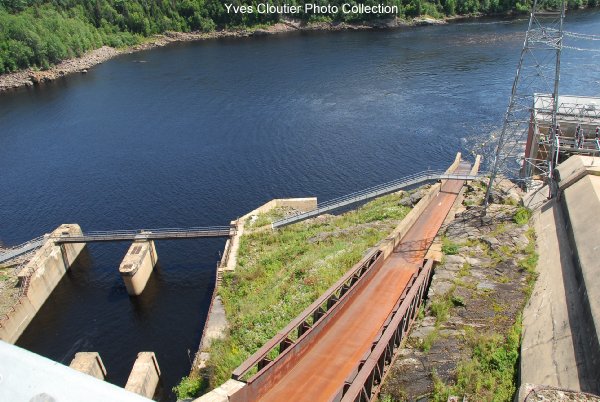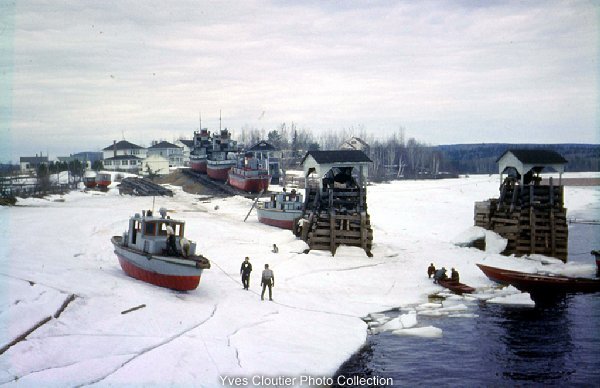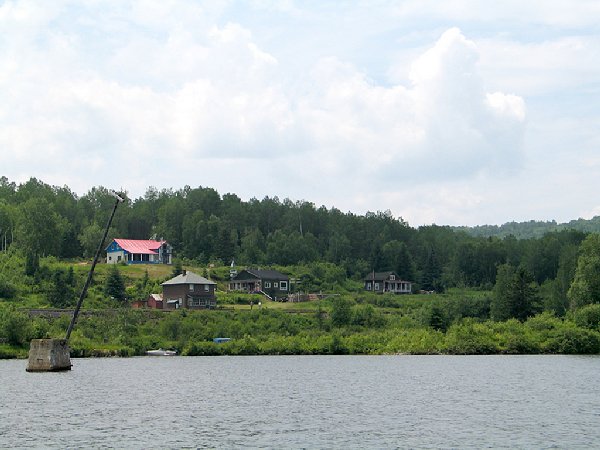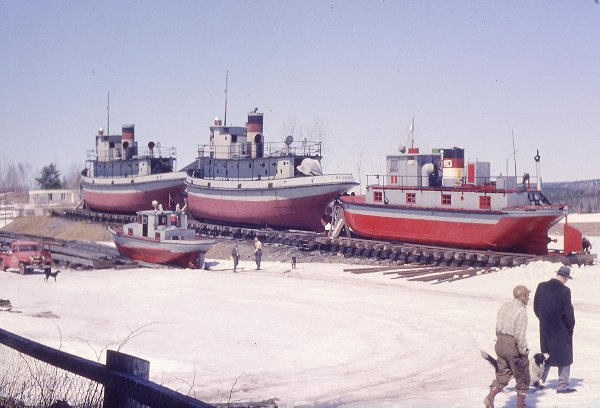Russel Brothers Limited OWEN SOUND, ONTARIO Steelcraft Boat Builders
 |  |
|
The Yves Cloutier Collection
ABOUT YVES CLOUTIER STMRD LOGGING IN THE 1980'S WINDIGO, QC - THEN & NOW
Yves Cloutier worked in logging near Beaumont, Québec for four years between 1978 and 1982, pushing logs around using Russel tugs. His photos give us a clearer idea of what modern logging operations are like, and a glimpse of how it was before that.
Here is a 4.5 minute silent video of the St. Maurice River jammed with timber in Québec, Canada.
At 1:50, we see Russel boats ploughing through, and shoving timber over the dam at Rapide Blanc.
There is a thrilling bow point of view as the tugs near the top of the chute! 4:23, wmv.
LO RES 4.5 megs HI RES 17 megs
WMV source: British Pathe PLC https://www.britishpathe.com/product_display.php?searchword=St+Maurice
Yves Cloutier notes: The Henry Sorgius and the Rapide-Blanc operated on the La Trenche Reservoir.
The Amisk, the La Trenche, The Flamand, The Coucoucache and The Rapide-des-Coeurs were on
the Rapide-Blanc reservoir. There is only 14 mile road between Rapide-Blanc and La Trenche.
| Unidentified Russel Boats |
Unknown ????
Russel type winch boat, with square stern. Slip says "reserved - Baby Dan".
Sorel or Verchère, QC, July 8th, 2006. 1024 pixels wide YC PHOTO 600 DPI SCAN | |
| About Yves Cloutier...
"My father (Roger Cloutier) was the mechanic for a few Russel tugs, Coucoucache, Rapide-Des Coeurs, Flamand, Rapide-Blanc, La Trenche, Henry Sorgius, R.J. Beaumont, J.V.Perrin and Amisk. All were equiped with Cummins engines. He was working for "La Compagnie de Flottage du St-Maurice", or St-Maurice River Drive (STMRD) Company.
From my first steps to the age of 18 I spent much time with my Father, I was his designated operator to go for a test ride after each repair or oil change. I was operating the boat as my father was checking for leaks and any other problems that were developing.
While I was a student I became operator and was working on the tug between 40 and 60 hours a week from May to the end of August. I was paid to have fun, for me it was the best student job I could expect! Working on the tug was noisy and some times, smelly when you are going with the wind. Most of the tugs used at the STMRD were used to push the logs into a log chute, at Rapide-Blanc, La Trenche and Beaumont Dam. When the wind was against us, we had to pull the logs in front of the Dam chute using a boom (sometimes near a mile long) to squeeze them over the Dam.
Was it dangerous?..... maybe. An engine failure could make the tug jump over the dam. At Rapide Blanc, the gate where the tugs were passing the dam was 52 feet wide and 9 feet deep. If the tug failed to reverse that would have been the end...... 100 feet drop in the chute! Bye bye boat and operator. Thankfully, It never happened but I saw some guys get into serious trouble at other Beaumont Dam. Luckily, the tug turned sideways and could not jump because the chute was adjusted to let only 3 feet of water go down the chute. The operator was caught by the strong side current at lunch time (more on that below). I always had total confidence in the mechanic of the tug I was operating and never worried about mechanical malfunctions.
Another problen was the changing conditions in front of the dams. Hydro has to deal with the electricity demand, and at the peak hours between 10AM and 1PM, and around 5 PM, the current generated by the increased water flow in the turbines could pull a tug onto its side. The reverse manoeuver after pushing a "bunch" of logs at the dam was tricky. As you probably know, these tugs were not easy to control on reverse. The Amisk was the worst and no matter the rudder position, it was the boat that decided where it was going... A little kick forward and back to reverse and you had control.
In July, working on the tug was tough because of the heat, probably like spending the day under the hood of a truck.
This job was good experience. A few years ago, I was invited on a sail boat and we were caught in a storm. The captain was a little surprised on how his guests were able to take control of the boat when he realised that we were in serious trouble with a sail that would not come down. All he asked me before the ride was if I ever was on a sail boat, the answer was a strong no! I guess 4000 hours on a 37 ft Russel Tug is like riding a bike, you never forget.
In the 1970s, the ministry of transportation started to inspect the logging work boats and minimum safety equipment became mandatory...the little rooftop boat, fire extinguishers, water buckets, axes to cut cables in case a boom jumped in the log chute and reserve life jackets on board. On the St-Maurice river, side railings were added, side boards were widened and a special protection had to be installed to protect the operator in case of a steel wire break during winching... particularly dangerous when the boats were pulled out of the water using the winch!
- Yves Cloutier, Ing., January 2006.
|
Beaumont Chute
Photos of logging operations at Beaumont Chute, Québec between 1978 and 1982, when Yves Cloutier worked there. The Beaumont Dam is on the St-Maurice river 10 miles from La Tuque, QC and it entered Service in 1958. The STMRD (La Compagnie de Flottage du St-Maurice) was owner of the boats. The STMRD ended it's operations in 1998.
| |
Beaumont Chute 1978
Moving logs toward the chute over the dam (not visible to left), note the Russel boats bottom left (R. J. Beaumont and J.V.Perrin)1024 pixels wide YC PHOTO 600 DPI SCAN | |
Beaumont Bateaux 1978
The Beaumont and the Perrin herding the logs into bunches. Note the jets toward photo bottom. The boats are facing upstream, the dam is to the left. Also note the "piece" on each boat overhanging the edge of the log containment area.1024 pixels wide YC PHOTO 600 DPI SCAN | |
Chute 2 1978
This would be what a tug crew would see if the boat got captured by the current and pinned at the edge of going over...1024 pixels wide YC PHOTO 600 DPI SCAN | |
Beaumont Jets 1978
These powerful water jets helped to get the logs away from the sides and over the chute, but the tugs had to keep clear of the side pipes and work through the extra currents generated.1024 pixels wide YC PHOTO 600 DPI SCAN | |
Poussage 2 1978
The RJ Beaumont left and the JV Perrin pushing logs in the chute at the Beaumont dam a few miles from La Tuque in 1990.1024 pixels wide YC PHOTO 1661 PIXELS WIDE | |
| About STMRD Logging in the 1980's...
Each boat was diferent, R.J. Beaumont and J.V.Perrin were twin boats, Built and delivered together in 1958. Some time, I had to use the Perrin and the feeling on the wheel was totally different from the R.J. Beaumont. On the tug, the control of the winch while the propeller was working was also tricky, you don't want to break the wire. Have you ever seen what happen when it breaks.... it not nice and It can kill you if you get in it's way when it snaps.
In regard to the large timber at front of the boat, at about 30 foot long it was almost the length of the boat. This was used to push the logs toward the dam. It was lowered by releasing the winch break and stopped at the water level by applying the brake again; the pedal on the right if I remember. It was called the piece (liberal translation of "la pièce") and was raised using the winch. (SB notes in one Russel brochure the piece is referred to as "the pusher").
Look at the photos, in one of them the piece is down, and the logs are piling in front of the boat. Turning the boat will make the logs slide or stick to what we called the "bunch". The fun was to accumulate as many logs as possible without jamming the whole thing in front of the log chute. I would say it was a precision job requiring a lot of attention. In front of the chute, we were engaging the boat in reverse, pushing the throttle to the max in order to stop the boat being pulled down the chute. When every thing was safe, we raised the winch to lift the piece, lock the winch break and pushed the throttle to back on and turned the boat around for the next bunch.
Most guests I had on the boat were really scared.... and were most of the time running to the back of the boat while I was approching the log chute (also called the slide). We had to get very close because the logs were piled at least 4 feet high in front of the piece and without the tug pushing, would jam the entrance of the chute.
Notice also in the pictures, the chute entrance is equipped with strong water jets to help aligning the logs in the chute. We had to stay away from the jets in order to avoid damage to the side pipes. All the while fighting the lateral current when the dam turbines were working at full load during the peak electical demand hours.
All the boats of what was called the upper dirve on the St-Maurice river (Beaumont, La Trenche and Rapide Blanc) were equiped with 6 cylinder Cummins engines except the Rapide des Coeurs and the Coucoucache. The Amisk, for example, was equiped with a 250 turbo developping near 300 hp. All the boats remotorised by my father had Cummins 250 hp engines installed and had the side cooling tanks extended. The reason, pushing at the dams was tough because the boats were continuously jammed and surronded with logs.
As mentioned earlier, the STMRD was rafting the wood with the boats using the propeller, not the winch, another reason to get a stronger engine. Rafting is what we used to do when the wind was not helping to bring the logs near the dam to be pushed down the log chute! We were going up the river with a long boom then circle the logs to form a big "U" with the boom to trap the logs. One tug each end each of the boom each on our side of the river. we were generally able to catch 2000 to 3000 cords of wood on one raft.

Only on one occasion we had to use the winch to retreive a stuck boom after a storm. I could not believe the power of this thing, pulling the boat over the ground was an amazing event. The jam on that day was bigger than anyone had ever seen. When we started winching, only two things could happen, the boom was to come or we were to go to the boom.... with the pier! That was the only time in my life on the boat that I had to rev up the engine on the winch. Normally, winching was done at engine idle in order to avoid breaking the steel wire. Beleive me, with engines that could make 120 or 250 hp, it was easy to break it....and very dangerous.
- Yves Cloutier, Ing., February 2006. Addendum (Aug. 2006) ...To understand what logging was in the 80's, one must know that the river was shared. Logging operations were conducted during the week and logs were confined in a "boom corridor' between St-Roch and Grand-Mère. Boats such as the McNeil St-Roch were used to tow barges loaded with logs and anchors. The boat was also used to open and close booms. The logs were enclosed in booms on weekends and released at the beginning of the week by opening the booms. Opening a boom meant releasing one end to let the logs free, closing meant blocking the path of the logs by installing a boom from one pillar to another or from one side of the river to the other. The company had to clean some parts of the river and the best way not to leave anything behind was to load stray logs in barges. The anchors anchored the booms because it was not always possible to tie them to the shore. La Trenche Dam Log Chute...or slide. Aug. 2006.

|
| Windigo, QC: Then & Now
Windigo, QC, Start of Logging, c. 1960. The "Big Boats" of the STMRD.
Yves Cloutier notes: "These photographic slides came into my hands 20 years ago and were given to my family by Marius Pepin, an executive at the STMRD. Marius ALWAYS had a camera with him. They are the only color pictures of Windigo I know.
The date is the late 50's or may be early 60's, but definitively before 1964, the last year the Colonel Georges was used by the STMRD. The Weymontachingue and the R. F. Grant were built by Canadian Vickers in Montreal in 1934. I don't know if the Colonel was built by Vickers or if it could be a Russel. Any info on that would be appreciated."

| Yves Cloutier notes: "
Early spring in the late 50's, the water level is low in Windigo Québec (the far end of the Rapide-Blanc reservoir) and Coucoucache is "winching" itself to the open water, Flamand will follow. The Rapide des Coeurs already in the water his nose can be seen at the right near the pillar.
The mission was to get in position to winch the "big" boats to the water. I am not certain that this kind of work would be permitted today!
The Village was closed, it was a hub used by the Brown Corporation (a logging company) and closed the village in the early 1960's. A project to build a dam at Rapide Des Coeurs keept the village alive for a couple of years but, when Hydro Québec decided to stop the project to concentrate on the Manic 5 project, we were only a couple of families left in the village. In 1963, The STMRD decided to move all the boats to Rapide-Blanc (Windigo is at one end of the lake, Rapide-Blanc at the other end!). We moved to La Tuque and my father was traveling to Rapide-Blanc enther by train or with the company truck. The STMRD used our house and another one as a base camp till 1998.
Here's what it looked like in 2004!
The boat slip was on the right! Our house the green one, the CN section house in the front and the house of the St-Maurice forest on top of the hill.
Windigo, QC in 2004. Yves Cloutier photo.


| Yves Cloutier notes: "
In front, The Coucoucache, getting ready to turn itself around and "winch" itself to the water. In back, from left to right, The Weymontachingue, The R.F. Grant and the Colonel Georges...
The Colonel Georges will be winched to the water and will be used to crush the ice where required. The Colonel had a flat bottom. I remember once, when I was a kid to have been on board for one of these assignments. Wow, The boat approached the ice at slow speed, and when the contact was established, the operator had to push the engine to the max in order to climb up onto the ice, pushing the boat out of the water until the ice broke under the boat. Then, the power was relased to clear the ice from under the boat and the manoeuver was repeated until the path was open. Sometimes, one third of the boat would get on the ice before it broke. Jumping a log boom is thrilling, but crushing the ice is another experience, the feeling when the ice breaks and the front of the boat falls in the water is kind of scary.
I was 4 years old at the time and i still remember this day like yesterday. Even at that age, I was "driving" the boats, sometimes standing on a bench, my father taking care of the throttle as my arms were not long enough to reach it. I was also driving our car on my father's knees.... the advantage of living in the middle of nowhere!
Weymontachingue and R. F. Grant were used rafting logs between Windigo and Rapide Blanc. The Colonel was rafting and pushing logs at Rapide Blanc. The problem of pushing with this boat..... too much power resulting in massive jams in front of the log chute at Rapide Blanc, and just below the bottom of the chute.
The Weymontachingue has been renamed, SERVICE BOAT NO 2 and the R. F. Grant is still in service, they are owned by Le Groupe Ocean and are still in use on the St-Laurent. The R. F. Grant is in Trois-Rivières and is assigned to transport the pilots in winter... The Colonel was retired in 1984 according to Transport Canada site." |
|
|
|
For more Russel exhibits visit Owen Sound Marine & Rail Museum 1165 1st Ave West, Owen Sound, ON N4K 4K8
(519) 371-3333  http://marinerail.com http://marinerail.com | |
|
|
|